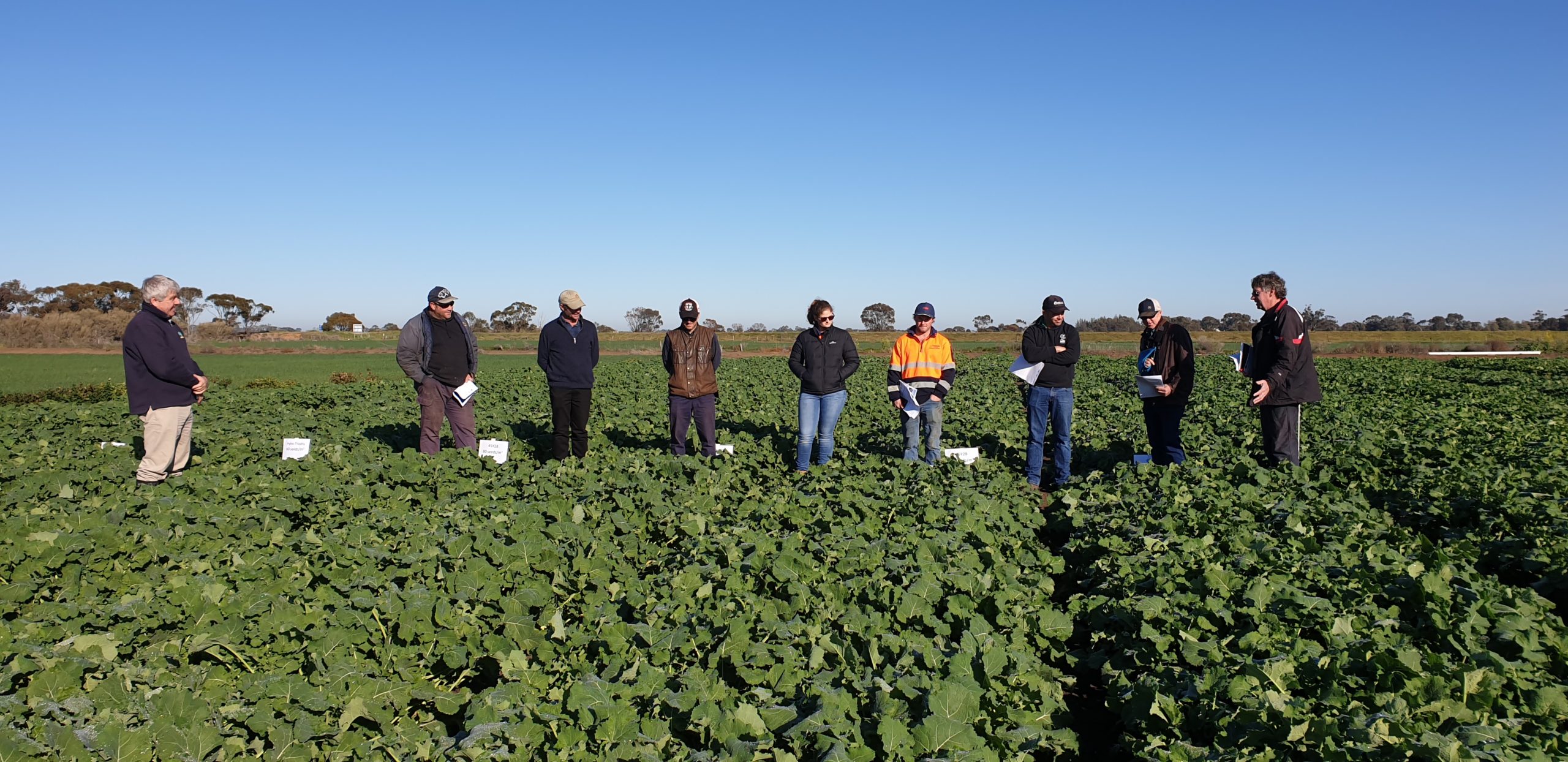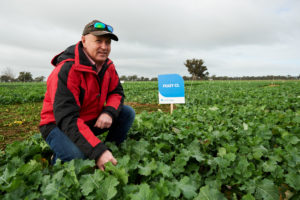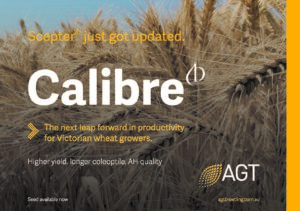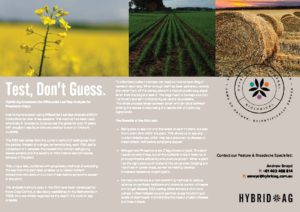2021 Spring Research Update
2021 Kerang Research Update
Given our our spring field day couldn't go ahead, we wanted to showcase our irrigated research in short video clips, online information and a special edition Trial Site Magazine.
Yet again in 2021 we re-imagined our field day to enable us to showcase our research site and provide information about the local trials taking place in 2021 in a virtual interactive format. This page has short videos and and details trials to give growers and industry key information about the research.
Members received our special edition trial magazine arriving in their mailbox.
Seasonal Summary
2021 started with a water market that made pre-irrigation economically justifiable. Climate models (although autumn is probably when they have the poorest reliability) were indicating an average to slightly wetter season.
Most trials were to be sown onto wheaten hay stubbles. Soil N at sowing was far less than 2020 (which followed brown manured vetch) and ranged between 70 and 90 kg N/ha. The first trials to be sown for the winter season were the Murray Dairy Fodder for the Future, planned for sowing in early April. Thanks to 42mm in late March, the first sowing occurred on March 31st into receding moisture, but with rain forecast. Pre-irrigation then happened for the rest of the trial area, starting on April 8th. As the forecast rain failed to materialize, the fodder trial was watered up/pre-irrigated as well. Sowing resumed on April 21st with the long season wheat trial, followed by the canola and cereal fodder trials.
April rainfall was very much below average with a decile 1, or 0.8mm for the month. May rainfall was below average (11mm), but this was just enough to keep moisture in the soil surface and allow sowing to go close to planned as possible – the main season wheat trial was sown on May 6th, barley and faba’s on May 7th, chickpeas on May 18th and the durum wheat trials on May 21st .
Another new project for the ICC is the national GRDC Canola Heat project. The aim of the project is to identify ecotypes and/or genes that will improve the heat tolerance of canola. This trial is made up of 24 selections of Brassica napus (the species name of canola) and these have been sown at 5 time of sowings (29/4, 25/5, 22/6, 13/7 and 9/8).
June and July saw average rainfall, with 38mm and 34mm respectively. However the rainfall occurred as many small events. June rainfall enabled us to sow the ‘non-trial’ areas to a mix of wheat and vetch as a brown manure, aiming to keep our ryegrass under control in anticipation for sowing to trials in 2022 and improve, or at the very least halt the decline of, our soil organic matter.
August was again drier than average, which resulted in the first irrigation in the Smarter Irrigation for Profit 2 (SIP2) trial on August 26th. This demonstration is on the ‘red dirt’ and had been pre- irrigated. The ‘grey dirt’ (the majority of the Trial Block) was irrigated on August 30th.
Stripe rust was observed in Trojan on September 3rd, with small ‘hot spots’ of septoria on Scout in our SIP2 demonstration prior to being sprayed with a fungicide at GS39 (full flag emergence). Other disease noted this season has been ascochyta in the chickpeas and very low levels of cercospera in the faba beans.
The start of September saw 16mm of rain shortly after irrigation, but no waterlogging occurred. The weather seemed to get stuck in a pattern of warming up with increasing wind during the week followed by a change over the weekend, sometimes bringing rain but generally resulting in poor totals. The second spring for the SIP2 demonstration was September 17th, and the second irrigation for the majority of the trials will be in late September.
2021 Rainfall, Irrigation and Accumulated Rainfall

Our Trials
To gain an insight into what’s going on at our Kerang trial site, click on the links below.

Irrigated Variety Trials
variety trials are comparative crop variety testing with standardised trial management, data generation and collection to provide meaningful results for growers. Irrigation provides a unique environment that allows high yields to be targeted. However most varieties are developed and tested under dryland conditions. In order to perform under irrigated conditions, a variety should have the following characteristics: High yield potential Maturity that matches sowing date and the optimal grain filling period (avoiding frost at flowering but also avoiding high temperatures during grain filling) High tolerance to crop lodging Waterlogging tolerance Good disease tolerance/rating, although a disease management plan can address some shortfalls The decision was made to separate the early maturing (or early season) varieties from the main trial, and to sow them at a more appropriate time that suited their maturity. Variety trials in 2021 include: Canola – 23 varieties and lines Barley – 15 varieties and lines Wheat – 19 varieties and lines Faba beans – 7 varieties and lines Durums - 9 varieties and lines

Fodder for the Future
Murray Dairy has partnered with the Irrigated Cropping Council through the Fodder for the Future project to conduct demonstration trials investigating management strategies for cereals and faba-beans as fodder for dairy cows. The first trial looks at the impact of sowing dates and seeding rates for wheat (Cesario) and oats (Forrester). Sowing dates were early and late April. Sowing rates were 80, 120, 180 and 270 plants per m . Two different cutting times will also be measured to understand the impact of harvest time on quality and yield for each cut. All plots have been sown with successful weed and pest free establishment. The crops are all growing well, with some plots quite advanced in their growth stage. This may create a management challenge if harvest time is very early.
Optimising Irrigated Grains
The project which has now completed its first year of results with winter crops and second year with summer crops has a major focus on examining the major agronomic levers that influence irrigated crop profitability. Of the agronomic practices being evaluated there is a major emphasis on nutrition asking the questions around how hard we need to push nitrogen (N) fertiliser inputs to achieve high yields under surface and overhead irrigation.
Optimising the return on nitrogen through improved nitrogen use efficiency has been a major focus of the initial trials in crops such as grain maize, canola, and durum wheat. In addition, the research is looking at the other major agronomic levers that can be manipulated to maximise productivity in irrigated crops, these include irrigation system (surface v overhead), sowing date, disease management, plant growth regulation and its effects on plant architecture and standing power. Below we have presented examples of trials underpinning these key findings.


Optimising Nitrogen Inputs
What's the latest from our Sponsors
Click on the tabs below to see the latest information from our partners about their products and services.
GrainGrowers Launches State of the Australian Grains Industry Report (2016 – 2021) & Podcast
GrainGrowers is proud to publish the ‘State of the Australian Grains Industry’ report every five years, with the latest version (2016 – 2021) launching in October.
The report is an amalgamation of insightful facts, findings and figures to help growers and industry representatives assess ‘where they’ve been,’ to better prepare for what lies ahead and capitalise on opportunities.
GrainGrowers is also releasing a complementary six-episode podcast to hear directly from growers across Australia and key industry players on what they’ve seen 2016 – 2021, plus challenges and opportunities on the horizon.
The State of the Industry report takes both a macro and micro snapshot of the ‘lay of the land,’ with topics including production, trade and market access, transport and infrastructure, and the policy environment.
The last five years mixed some of the best production years with some of the worst, as much of Australia grappled with drought. Booming markets, with barley into China and chickpeas into India, also suffered from crippling tariffs. Despite this backdrop, the sector performed well, with a gross value of production averaging $13 billion per year – a 1% increase on the previous five years.
Another theme evident throughout the report – reaffirmed in conversations with growers – is the importance of sustainability and the changing needs of consumers. Market commentators and innovative growers affirm that whilst we can’t predict what will happen in the future, we can benefit from a robust strategy to help the sector meet future challenges.
Improvements in technology are assessed for their ability to change what’s possible even under harsh weather conditions, strengthening the future of grain growing in a changing climate.
An innovative sector, filled with innovative growers, will continue to embrace opportunities to increase production and meet the ever-changing needs of discerning consumers.
If you would like to read GrainGrowers’ State of the Australian Grains Industry Report (2016-2021) please visit graingrowers.com.au. The podcast will be available on all major streaming platforms.

Stacked in your favour
As environmental challenges emerge across Australia’s agricultural sector, research and technology continue to open new doors.
One of the most recent instances of this is herbicide-tolerance stacking in canola hybrids.
Justin Kudnig, Pacific Seeds national canola technical manager, is confident that these dual-stacked hybrids will deliver notable benefits to Australian canola growers.
“Our three new canola hybrids have been adapted to grow across all states, and with high yields, high oils and an excellent tri-gene blackleg rating of R, these hybrids will be a strong addition to any farmer’s rotations.”
He notes that these hybrids provide enhanced solutions by taking integrated weed management programs to the next level, adding protection against chemical carryover from previous crops – and have also proven to deliver competitive financial returns per hectare.
“As Aussie canola growers experience the full commercial value and agronomic protection provided by dual-stacked technologies, they will be able to see the advantage firsthand of adding products like Hyola Enforcer CT and Hyola Garrison XC to their program.”
And he isn’t alone in this assessment. Agronomists and growers are all seeing favourable results.
Craig Farlow, tech services manager for Victoria and the Riverina at Elders Rural, works with an agronomy team to run trials.
“We work very closely with our key partners, such as Pacific Seeds, to demonstrate in the field, in the local environments, in the different seasons,” he said. “Because it’s really important for growers to see how these technologies perform in the good seasons, as well as the marginal seasons.”
Craig noted several benefits from hybrids with dual-herbicide tolerance, particularly when it came to managing hard-to-kill weeds.
“With dual-technology varieties, we’ve got multiple modes of action, and we can ensure that we’ve got a clean paddock. And coming into harvest, we’ve got the opportunity to make sure that there’s no weed seed set for the following season.
“We’ve also got more flexibility in terms of managing weeds and managing resistant weeds.”
Gerard Bardwell, from Vectis – ten-kilometres west of Horsham – grows wheat, barley, canola and pulses.
“We’ve chosen the [Hyola] Enforcer CT in this situation for a couple of reasons,” Gerard stated. “It enables us to get some IMI chemistry onto the canola. We use a high rate of Sentry as an IBS-type situation. That does a really good job at controlling a whole range of broadleaf weeds – but also gives us some really good residual control.
“The other important part is making sure we get that full rate of triazine onto the canola as well. So we’re using that as an early post-emergent option and giving it the best possible chance to control any escaping ryegrass from our pre-em.
“The canola’s doing a great job in setting up the rest of the rotation for us. It’s getting good weed control in that particular year, but it’s also handling any potential residual constraints that may be there as well.”
There are others who have seen the benefits of stacked technology, and are looking at integrating it into future seasons. Ash and Brad are agronomists for Tylers Rural, in Stawell and Rupanyup respectively. With a history of annual ryegrass issues in their area, they see double-stacked canola as an ideal solution.
“Traditionally in Rupanyup we’ve always been a Clearfield® area – but also triazines and Roundup Ready,” Brad said. “And now that we have the ability to have the stacked technology traits, using all in combination.”
Ash agreed, noting the potential for more versatile and effective weed control. “The Clearfield-Triazine [tolerant] canola allows us to use a different chemistry to control differing populations of resistant weeds within a paddock on a specific farm.”
To find out more about the dual-herbicide-stacked hybrids, visit pacificseeds.com.au/canola-stacked.

Recent Canola stories from Pacific Seeds can be seen on YouTube
Thinking of Maize this year?

Rubicon Expands Proven Technology On-Farm
Rubicon Water’s focus is to help the world’s farmers best manage their precious water resources. Rubicon’s solutions manage the distribution of water to approximately 1.5 million hectares of irrigated farmland in 17 countries, and have now installed more than 35,000 water measurement and control sites worldwide.
Rubicon continues to improve the water management solutions available to farmers with the introduction of their New Generation of FarmConnect.
FarmConnect leverages the proven technologies within Rubicon’s irrigation district solutions to deliver innovative automated gate and valve solutions on-farm that enhance irrigators’ operations to provide significant water savings, reduced labour and increased yields.
Account manager for FarmConnect, Kevin Saillard say’s “this new range of on-farm products are set to revolutionise surface irrigation. We’ve been busy running trials in both Australia and the USA and the outcomes are beyond what we could’ve anticipated. We’re seeing significant labour savings and yield improvements.”
“Our development team have dedicated a lot of time into formulating these products and we’re extremely proud to extend the technology to the ICC community of farmers.”
Independent studies have demonstrated that precision surface irrigation solutions can improve application efficiencies to 85% or better, while significantly reducing labour costs and enhancing yields. Precision surface irrigation has minimal input energy requirements, allowing high application efficiencies to be achieved with low energy bills.
Satellite, soil moisture and climate inputs, plus communications via IoT-enabled nodes help farmers know when to irrigate their crops and how much water to apply. The cloud-based software provides farmers with irrigation scheduling and the ability to operate the system from any device, anywhere in the world. This enables the management of on-farm devices via a single platform.
Rubicon’s FarmConnect footprint is growing in the GMID area, with the adoption of precision surface irrigation gaining increased attention from innovative crop farmers.
Automation via remote control, monitoring and scheduling of irrigations, plus the provision of predictive data are just some of benefits that irrigators are seeing from their investments – ultimately freeing their time for other tasks.

Watch Video – NextGen FarmConnect Solution Overview video
Become a Member
To get the results from our variety trials, join ICC or renew your membership.
ICC Partners
















